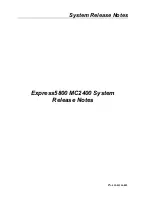
UMN:CLI
User Manual
V8102
428
9.7
Dynamic Host Configuration Protocol (DHCP) for IPv6
Dynamic Host Configuration Protocol (DHCP) for IPv6 provides a device with addresses
assigned by a DHCP server and other configuration information, which are carried in op-
tions. DHCPv6 offers the capability of automatic allocation of reusable network addresses.
The basic DHCPv6 client, server and relay agent concept is similar to DHCP for IPv4. An
advantage of DHCPv6 for dynamic address assignment is that it is capable of providing
additional information to the nodes. DHCPv6 provides DNS information and uses a 16-bit
option space.
DHCPv6 can record addresses assigned to hosts and assign addresses to specific hosts,
thus facilitating network management. And it assigns prefixes to devices, thus facilitating
automatic configuration and management of the entire network.
A node may autoconfigure addresses based on router advertisement (RA) under IPv6 en-
vironment.
DHCP Unique Identifier (DUID)
Using a DHCP unique identifier (DUID), each DHCP for IPv6 client and server is identified.
A DUID is used to identify the device when exchanging DHCPv6 messages. The DUID is
designed to be unique around all DHCPv6 clients and servers, and it is stable for any
specific client or server. A DUID can be no longer than 128 octets. There are three types
of DUIDs.
-
DUID-LLT (Link-layer address plus time)
Link-layer address of any one network interface that is connected to the DHCP de-
vice at the time that the DUID is generated.
-
DUID-EN (Enterprise number)
It consists of the vendor
’s registered private enterprise number as maintained by
IA_NA followed by a unique identifier assigned by the vendor.
-
DUID-LL (Link-layer address)
It consists of the link-layer address of any one network interface that is permanently
connected to the client or server device.
An Identity Association (IA) is a construct through which a server and a client can identify,
group, and manage a set of related IPv6 addresses. Each IA consists of an Identity Asso-
ciation Identifier (IAID) and associated configuration information. A client should associate
at least one IA with each of its network interfaces for which it is to request the assignment
of IPv6 addresses from a DHCP server. There are three main IPv6 prefix types: IA_PD,
IA_NA, and IA_TA. Each Identity Association for Temporary Address (IA_TA) option con-
tains at most one temporary address for each of the prefixes on the link to which the cli-
ent is attached. The clients ask for temporary addresses and servers assign them. An
Identity Association for Non-temporary Address (IA_NA) carries assigned addresses that
are not temporary addresses. An Identity Association for Prefix Delegation (IA_PD) is a
collection of prefixes assigned to the requesting router. Each IA_PD has an associated
IAID.
Содержание V8102
Страница 1: ...1 V8102 GPON OLT system User Manual...
Страница 158: ...UMN CLI User Manual V8102 158 When you use the no snmp command all configurations of SNMP will be lost...
Страница 427: ...User Manual UMN CLI V8102 427 show debugging dhcp Enable Global Shows the debugging information of DHCP...
Страница 797: ...User Manual UMN CLI V8102 797 show onu gsp status config ONU_ID tag list number TAG_NAME tag name...















































